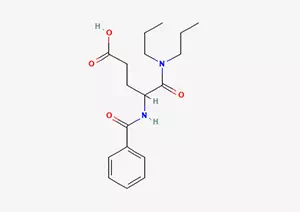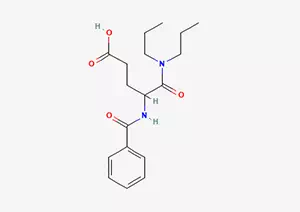All Categories


proglumide CAS 6620-60-6, proglumide, CAS 6620-60-6
In the exploration and research of various drugs in the medical field, glutamine holds a particularly special position. It can be regarded as the earliest discovered gastrin antagonist.
CAS : 6620-60-6
Formula : C18H26N2O4
Mol. wt. : 334.41
EINECS : 229-567-4
Chemical Name | Proglumide |
Other Name | Dipropyl glutamine |
CAS | 6620-60-6 |
EINECS | 229-567-4 |
Type | Pharmaceutical, pesticide, dye intermediates; API |
Molecular Formula | C18H26N2O4 |
Molecular Weight | 334.41 |
Melting point | 148-150°C |
Boiling point | 471.21°C (rough estimate) |
density | 1.1944 (rough estimate) |
refractive index | 1.5700 (estimate) |
storage temp. | Keep in dark place,Sealed in dry,Room Temperature |
solubility | DMSO (Slightly), Methanol (Slightly) |
form | Solid |
pka | 4.51±0.10(Predicted) |
color | Crystals |
In the exploration and research of various drugs in the medical field, glutamine holds a particularly special position. It can be regarded as the earliest discovered gastrin antagonist. It is worth mentioning that there is a close connection between glutamine and azolipide. Both belong to the derivatives of glutamine. This origin relationship makes them have certain similarities or correlations in terms of chemical properties and possible pharmacological effects.
Proglumide is also a substance worthy of attention, as it exhibits the characteristics of racemic compounds. It has an exact chemical name, namely (±) -5-dipropylamino-4-benzylamine-5-oxyvaleric acid, and is named Proglumide in English. Moreover, it is included in the authoritative "Chinese Pharmacopoeia" 2000 Edition, Volume 2, page 96. This inclusion reflects its significance in the medical field and its verified standardization and other characteristics.
From the perspective of its pharmacological effects, Proglumide is a gastrin receptor antagonist, and this function is closely related to its unique chemical structure. Its chemical structure is quite similar to the terminal chemical structures of the two intestinal kinin, gastrin (G-17) and cholecystokinin (CCK). This structural similarity lays the foundation for it to exert its corresponding effects
Basic. Specifically, the functional amide group of Proglumide can specifically compete with gastrin for the receptor of gastrin on parietal cells. Based on such a competitive mechanism, it can significantly inhibit the secretion of gastric acid and pepsin caused by gastrin. However, it has no effect on the secretion of gastric acid triggered by histamine and vagus nerve stimulation. This characteristic has many aspects worthy of in-depth exploration in practical medical application scenarios. The specificity of its function also makes it have unique value and significance in the treatment of specific diseases or related research, which is obvious.
In in-depth research in the medical field, the substance alanine has been fully proven to be a δ -opioid agonist. In the process of complex physiological mechanisms and pharmacological effects, this characteristic it possesses plays an important role, especially in analgesia, and may have a non-negligible contribution to its overall analgesic effect.
From the perspective of its chemical properties and mechanism of action, it is a non-peptide oral active cholecystokinin (CCK) -a /B receptor antagonist. This means that after entering the human body, it can bind to the receptor related to cholecystokinin in a specific way, thereby exerting the corresponding physiological regulatory effect.
Specifically in terms of drug application, propylamine (with mild pharmacological effects) is a drug used in clinical practice for specific therapeutic purposes. Its main mechanism of action lies in its ability to effectively inhibit gastrointestinal peristalsis, rationally regulate the movement rhythm of the gastrointestinal tract, and prevent excessive peristalsis from causing discomfort to patients. At the same time, it can also reduce the secretion of gastric juice, which is of great significance for maintaining the acid-base balance in the gastrointestinal tract and protecting the mucosa.
As a cholecystokinin antagonist, the role of proglumide is very crucial. It can precisely block the CCKA and CCKB subtypes. Through this specific blocking effect, it regulates the physiological effects of cholecystokinin in the body. In clinical treatment, it was once mainly used to treat the disease of gastric ulcer. In the medical environment at that time, it brought hope of alleviating the pain to many patients with gastric ulcers. However, with the continuous deepening of medical research and the increasing progress of drug development technology, it has now been replaced by a series of more advantageous new drugs.
In addition, acrylamide also shows selective blocking of the effect of CCK on the central nervous system in terms of its mechanism of action. This selective blocking ability enables it to effectively intervene in the related effects of CCK in the central nervous system without affecting other normal physiological functions.
It is worth mentioning that proglutamide also has important pharmacological effects. It has the function of inhibiting gastric juice secretion and can form a protective regulatory mechanism in the gastric environment, reducing the irritation of digestive juices such as gastric acid to the gastric mucosa. At the same time, it can also protect the mucosa of the stomach and duodenum, enhance the barrier function of the mucosa, and prevent harmful substances from causing damage to the mucosa. In addition, alanine also has antiepileptic and antioxidant activities, which makes it have certain research value and application potential in the fields of neurological diseases and antioxidance-related treatments
* Prompt reply and 24 hours online, professional team to provide best price and high quality product.
* Sample testing support.
* Every batch of products will be tested to ensureits quality.
*The packing also can be according the customers` requirment.
*Any inquiries will be replied within 24 hours.
*we provide Commerical Invoice, Packing List, Bill of loading, COA , Health certificate and Origin certificate. If your markets have any special requirements, let us know.